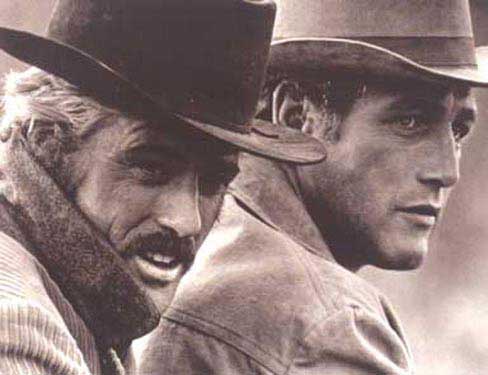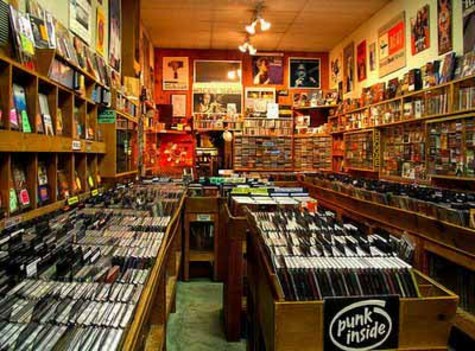Synopsis:
Notorious outlaws Butch Cassidy (Paul Newman) and the Sundance Kid (Robert Redford) once ruled the dusty towns and breathtaking vistas of the Old West. But when a relentless “superposse” picks up their trail, they realize their days are numbered. With Sundance’s girlfriend, Etta (Katharine Ross), they flee toBolivia. But old habits die hard, and when they their thieving ways continue, Butch and Sundance find themselves outgunned, outnumbered and in the fight of their lives.
Review:
According to the American Film Institute, the Western is a genre that depicts: “a struggle between the good and evil in a setting where civilization and wilderness are in transition”. In the early years of cinema, the western was defined by many iconographic boundaries. The heroes wore white while the antagonists wore black. They were easily identifiable for audiences watching these stories.
However, in the times occurring after World War II, the western took on new meanings and understandings. They began to embody darker themes and reflect upon the complex nature of violence. The challenge of defining who were the “good” guys and who were the “bad “guys was no longer an easy black and white issue for audiences. The selections were tainted now as elements of good and evil now began to infiltrate and resonate within key character of these films. Classic films such as Fred Zinneman’s High Noon (1952) and John Ford’s The Searchers (1956) were significant entries in the postwar western and which embodied these key thematic elements.
As the 1960s rolled around, the western underwent even greater transitional stages. The western of the 1960s became comedic, satiric and violent variations on the genre. Films such as Sergio Leone’s The Good, The Bad and the Ugly (1966), Sam Peckinpah’s The Wild Bunch (1969) and, of course, Butch Cassidy and the Sundance Kid came to be films that helped to define the western genre during this tumultuous decade.
Butch Cassidy is far from a perfect film. In fact, it has numerous flaws such as sluggish pacing and alterations in tone that at times seem bewildering. What it does have going for it though is its impact on the cinematic landscape and as the first film to team the wonderfully talented duo of Newman andRedford.
There have been many talented duos affiliated with the cinematic stratosphere. Laurel and Hardy, Abbot and Costello and Pryor and Wilder, but none may illicit such raw visceral power as the teaming of these two iconic giants of the silver screen. To say that Newman andRedfordhave great chemistry together (and great comedic timing) is a very underwhelming statement. They sparkle when they are on screen with one another and the film truly benefits as a result. Who knows how this film would have fared if other actors had attempted to take on the roles of these two anti-heroes.
That is one key element of the 1960s western that continues to be truly provocative for critics and analysts. This idea of the anti-hero becoming an out right hero against government established institutions can be read as a statement and as an indictment of 1960s culture. The 1960s are a decade that saw great change and turmoil. Society had become fed up with the lies and deception perpetrated by a government that did not seem to care. As a result, the Civil Rights Movement, the Sexual Revolution, Feminism and Anti-War protests and rallies came to be defining moments of this era. The underdog was challenging the structure of government authority.
To understand the time period truly aids in the reading of Butch Cassidy and the Sundance Kid as a classic and as an important reflection of social and political turmoil. Butch and Sundance are two outlaws who defy society’s defined boundaries of lawful action. They live uninhibited and create chaos and paranoia for society in the film and thus establish a sense of lawlessness. The fact that they rob banks and trains run by the government helps to further solidify their roles as outsiders determined to challenge the authority of the land.
In an attempt to squash this up-rise by these anti-heroic figures, the government hires a super posse to track these men and kill them. Any threat to a government established society is a danger that needs to be eliminated. No matter where Butch and Sundance go, they cannot shake the likes of these government men and thus are forced to flee their established land and travel to a foreign territory unknown to any of them. The fact that the government hires these men to kill Butch and Sundance is a damning shot at socially established rules. As has been noted, the 1960s were about an uprising of political, social and personal beliefs and the established institutions at the time were unaware of how to cope. This perfectly mirrors Butch and Sundance. They cannot be suppressed so then they must be eliminated. If a soul cannot be contained then it must be destroyed. The story of Butch and Sundance perfectly brings this reality of 1960s society to light.
To look at Butch Cassidy and the Sundance Kid from a historical perspective helps to understand the film in a new and innovative way. To define it alongside the political turmoil that was the 1960s helps to create an unforgettable aura about the film. Just as in the final scene where the image of Butch and Sundance is freeze framed (thus solidifying their roles as iconic heroes), the film now becomes destined for iconic status because of its role as an important historical document which helped to define an era.



